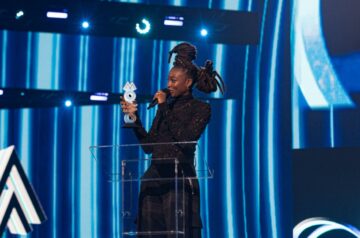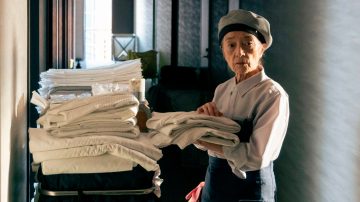
This Star Wars day, John Moore takes a look at how Great Britain has shaped the iconic film franchise, right back from its early days through to the more recent instalments.
It’s common for films to credit national or regional governments for their role in supporting a film, but it’s rare for specific politicians to receive credit. However, when The Force Awakens hit screens on a tsunami of hype in 2015, it didn’t take long for people to notice the prominent positions in the film’s credits afforded to then-Chancellor George Osbourne and Culture Minister Ed Vaisey. Even if you missed that detail, it was harder to avoid their attempts to mine political capital for their roles in luring Lucasfilm back to Pinewood Studios.
Star Wars was a significant quarry, and therewere rumours circulating of meetings between Osbourne and Lucasfilm’s Kathleen Kennedy almost as soon as she was appointed to run the once-eponymous company by Disney. Also, Osbourne had been a notable attendee at the opening of the Industrial Light and Magic (ILM) UK offices, a move subsidised by his various government grants.
Shooting The Force Awakens in the UK seemed great PR, but the HMRC’s relaxation of the tax-relief conditions for films, signed off by the exchequer in 2014, became something of a cause célèbre. The most eyebrow-raising element to it was that the changes allowed the none-more-American, far-from-struggling Disney to label the movie – for tax purposes at least – as a British Film, and benefit from the rebates that came with such a classification. Indeed, it still does: among the UK-made Disney films of recent times are the remake of Dumbo, Mary Poppins Returns, Black Widow, Cinderella, and Cruella, as well as the other two Star Wars sequels, alongside Rogue One and Solo. In 2020, it signed up for a 10-year lease for the exclusive use of the entire Pinewood facility, ensuring that it could continue working in Britain. This followed it being effectively locked out of Shepperton – another UK facility it was fond of using – thanks to its exclusive deal with Netflix.

Image credit: Independent.ie
Born of Necessity
Back in 1975, when Alan Ladd Jr – then an executive at the struggling 20th Century Fox – was sticking his neck out to fund an up-and-coming director making a weird sci-fi movie, shifting Star Wars’ production to the UK was a financial decision born of necessity rather than maximising profit. Even Universal, for which George Lucas had made buckets of cash with American Graffiti, had hard-passed on what would become A New Hope, with every other major studio had followed suit.
Fox’s financial sages allegedly saw Star Wars’ potential at the box office as distinctly limited, estimating the top-end gross would be in the region of $12m. Thus, it earmarked a measly $4m for production. Ladd Jr’s enthusiasm for Lucas’ vision was high, and his support for the movie never wavered, but the financial commitment he could expose Fox to only stretched so far. The lengths he would eventually go to in order to get Star Wars across the line, as budgetary limits were blown through, is well documented. However, less is said about how a British team of technicians, crew and cast helped the production get as far as it did before alarm bells began ringing back in LA, nor how distinctly British Star Wars became because of it.

Alternative Histories
It all could have been very different. Producer Gary Kurtz assumed that the film would be made on the Fox lot in LA, only to find that – as with all the other studios he contacted in Hollywood – there simply was not the capacity to accommodate the seven soundstages that he and executive in charge of production, Peter Beale, had decided were needed simultaneously to get the live-action aspects of the film in the can on time and budget. Not could it be seen how the film could come in on budget in the US.
When the team turned to Europe looking for capacity and cost cuts, the legendary Cinecittà studios in Rome (home to Ben Hur, Cleopatra and a slew of classic European and Hollywood movies) was Kurtz’s choice. However, amid peer scepticism of Italian crews, he was talked out of it. Whether these doubts were good old-fashioned xenophobia or not it left the UK as the only viable location option.
The choice was then whittled down by Pinewood’s refusal to allow British production supervisor Robert Watts to block book its entire facility, and Elstree’s willingness to cut what he would later call “the best deal I ever made” and turn its whole site – including workshops – over to Star Wars’ production for £75,000 all-in. So, Elstree it was… and Elstree it would remain for the Original Trilogy, augmented by an additional, massive, soundstage funded by the filmmakers for the Hoth Base sequences of Empire. The massive Yavin Temple sets for Episode IV and Rogue One: A Star Wars story, would be shot 50 miles up the Midland Mainline at the massive former Airship hangers and RAF facility at Cardington – known as the ‘Sheds’.

In a foreboding shot of the duel that was to come, Prince Harry and Prince William, Duke of Cambridge, try out light sabres during a tour of the Star Wars sets at Pinewood studios in April 2016.

Lucky Find
The next piece of the production jigsaw would drop into place when writers Willard Huyck and Gloria Katz (who’d worked on American Graffiti) turned Kurtz on to work being done for Stanley Donen’s Liza Minella/Burt Reynold’s/Gene Hackman-starring Lucky Lady in Baja, California. A visit there by the producer and director would lead to set decorator Roger Christian, art director Les Dilley, production designer John Barry and their team getting pulled aboard for the UK-based project. All would become central to the look and feel of Star Wars, as the team realising Lucas’ wish for authentically aged and dirty sets. Barry, though less pleased with the aesthetic than Christian, was key to bringing together Star Wars’ sets and props in a wonderfully resourceful way.
ILM’s use of so-called ‘Greebles’ or ‘Greeblies’ – terms often credited to George Lucas to describe the vast array of ‘kit-bashed’ and real-world objects model makers apply to make ships and scenery interesting and authentic – has been widely lauded. However, while that team was only just getting started on its groundbreaking effects work in LA, the UK production team was applying similar principals on a grander scale to its life-size sets and props. Freed from the need for any kind of historical verisimilitude, Christian and Barry fashioned their vision of Lucas’ galaxy using tonnes of stripped-down and repainted aeroplane scrap, bought at a bargain price.
Roger Christian’s now-iconic array of weaponry designs were similar Frankenstein-like creations. Han Solo’s DL-44 blaster is based around a Mauser C96 pistol supplied by prop weapon specialist Bapty, again kit-bashed with a silencer and night-sight grabbed from a spares box there, along with other accoutrements. Chewbacca’s Bowcaster comes from a unique crossbow that caught his eye, while stormtrooper weapons are based around modified Sterling submachine guns. His legendary find, though, was a box full of 1940s Graflex flashbulb handles, salvaged from a long-forgotten box under the counters of Brunnings, a photography shop in Central London. Augmented, again, with Greebles, one of these would become the handle of Luke/Anakin’s lightsaber.

This Sunderland- supporting Stormtrooper.
You Won’t Get Me
In front of the camera, the largely British cast was assembled to appease Equity, the actor’s union. Its fervent protection of parts that could go to card-holding, homegrown actors led Peter Beale to play down the roles of Ford, Fisher and Hamill in his provisional cast list, and promote British stars to the top billings in order to obtain the project’s required permits. Of course, this necessity served to give Star Wars a very different accent from many big-budget adventures, and the gravitas of Guinness and Cushing helped to sell the oft-expository dialogue. The British accent would then always signify the Empire, whether it be Ian McDiarmid’s Palpatine, Christopher Lee’s Dooku, Kenneth Colly’s Piet, Michael Sheard’s Ozzell or countless other character actors – we never did get David Prowse’s Norfolk take on Vader, though – at least not officially.
Unions would not be so helpful on around Elstree, though. While the British team moved heaven and earth (or at least a lot of sand) to get the infamously problematic Moroccan shoot completed on schedule, when things got back to London Kurtz and Lucas found themselves frustrated by the rigid working rules imposed by the Elstree foremen and the fastidious, regimented production methods expected by the crew. Lucas’ sparing, somewhat laissez-faire, indie-inspired style of shooting raised eyebrows among continuity, cinematography, and editing staff used to lots of coverage and traditional blocking, while Kurtz and Lucas complained to Beale about the rigid working hours. Beale told them they’d have to learn to work around both issues, as many had before. Eventually, they did – conceding to certain requests for extra footage and then by running three production units simultaneously across multiple stages to complete the list of shots needed on schedule.
While Harrison Ford once – in typically lugubrious style – told the BBC that working with a British crew was basically the same as working with Americans, apart from the fact they “drink more tea,” Kurtz quickly realised that another drink was having an influence on Star Wars. He claims a lot of important decisions were being made about production problems over a pint in Elstree’s local after work had finished. Thus, he began to ingratiate himself into the crew’s Pub visits culture to ensure he was part of those conversations and ease relations.

Prequels and Sequels
Later Star Wars films would create legends of their own in terms of production. The late Richard Marquand would become the first British Star Wars director on Return of the Jedi, and Gareth Edwards would pick up that baton for Rogue One. Ironically, questions would be asked regarding how much either man was in control of the finished product bearing their name, though – though Tony Gilroy was apparently in control of the additional shooting for the latter. Behind the camera, the legacy of the model makers will always live on in Yoda – both in terms of his resemblance to his creator, Stuart Freeborn, and the skill of the British technicians that made that design work so beautifully.
On a larger scale, there will soon be a permanent exhibit in the Welsh town of Pembroke Dock to commemorate the 1979 construction of a full-sized Millenium Falcon for Empire by the town’s Marcon Fabrications. Built – with George Lucas’ penchant for using decoy titles – under the project name of ‘Magic Roundabout’.
Moving on
For the Phantom Menace, Lucas would return to the UK – to what is now Warner Bros. Leavesden Studios – for principal photography, leasing the facility for over two years, so the lavish sets could stay in situ. It was the last of the saga to be shot on 35mm – by Brit, David Tattersall – and the last time Lucas worked in the UK. He chose to shoot Episodes II and III at Fox’s Sydney Facility, a shift that bought with it a very different voice for many of the peripheral characters – not appreciated by all. Thus, it became part of the Disney peeling back of the questionable Prequel legacy for the film to feature more of the practical effects of the Originals, and be shot in the UK using UK talent. This time Brit actors Daisy Ridley and John Boyega would, of course, take centre stage… Well, alongside George Osbourne and his tax cuts.




